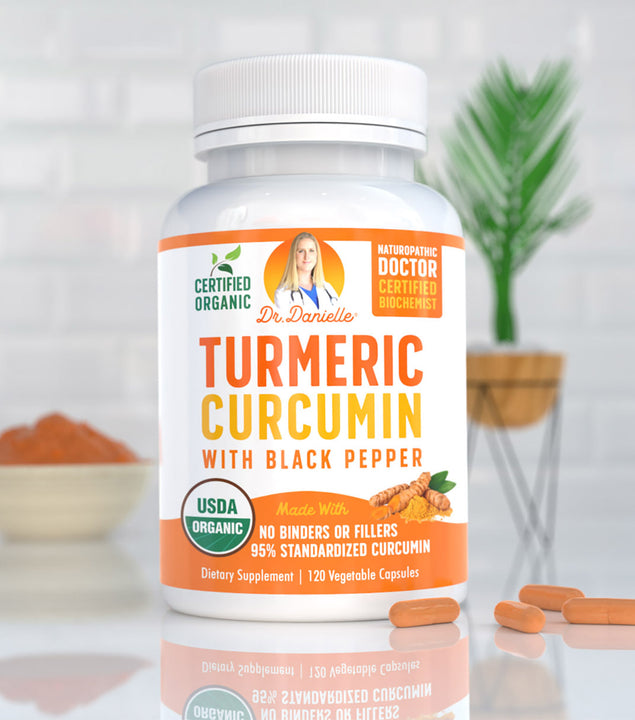If you suffer from food allergies, you’re probably more than familiar with the following scenario. Eat so much as a tiny piece of the offending fare, and it can feel like your immune system is gearing up for the apocalypse. Cue symptoms like hives, sneezing, headaches, and more embarrassingly… Flatulence. Not fun. But, hey, here's a thought. What if your so-called food allergies aren't what they seem? Especially if they've never been officially diagnosed by a doctor? It may be worth considering that all the icky 'food-allergy' symptoms you've been experiencing could instead be a sign of histamine intolerance–a lesser-known condition that develops when there is an excessive build-up of histamine in your body.
Confused? Not even sure what histamine is? No worries. Here's everything you need to know about histamine intolerance, including what you can do about it so that you can bid farewell to that pesky mid-day migraine.
What Is Histamine?

On the off chance that you've popped an antihistamine pill or two before, then you likely already have an inkling of what histamine is. Regardless, though, histamine is a chemical compound that your body naturally produces; it's involved in immune function (1, 2, 3). More specifically, it's the chemical that your immune system produces when you're exposed to an allergen or harmful substance. The release of histamine, in turn, causes inflammation and dilates your blood vessels, leading to various annoying symptoms you're well-acquainted with, including itching, swelling, hives, runny nose, and watery eyes, that all help to protect the body.
Of course, histamine’s actions are great for protecting the body against harmful substances. But it’s not so great when you suffer from histamine intolerance, known to affect roughly 1% of the global population–where your body overreacts to foods high in or contain histamine (i.e. harmless substances) (4). Thankfully, you’re not entirely helpless when it comes to this situation. And one thing you can do to prevent yet another uncontrollable sneeze attack is to adopt the low-histamine (or histamine-free) diet.
What Is A Low-Histamine Diet?

A low-histamine diet is pretty much what it sounds like. It is a type of elimination diet that tries to pinpoint 'trigger foods' by slowly taking out high-histamine foods and logging symptoms (5). For example, suppose you find that your symptoms have improved after removing a trigger food (e.g. cheese). In that case, you can omit that food temporarily and attempt to add it back into your diet in about a month–only, maybe at a reduced amount or frequency, depending on how you react to it. Your tolerance and symptoms will determine the rate at which you eliminate and add foods back into your diet.
Who Should Follow A Low-Histamine Diet?

Constantly experiencing some of the classic symptoms of histamine intolerance, such as constant migraines, sinus issues, hives, skin irritations, digestive issues, irregular menstrual cycle (for people who menstruate), tissue swelling, and abdominal cramping? Well… If you’ve ruled out food allergies and other gastrointestinal diseases (e.g. celiac disease), then you may be a suitable candidate for the low-histamine diet.
Before attempting the diet, though, your doctor is likely to measure your blood to test your diamine oxidase activity (DOA)–the main enzyme involved in histamine metabolism. Generally, research shows that the cause for histamine imbalance in people with histamine intolerance can often be attributed to a combination of too much histamine and a lack of DOA (6). Regardless, it's worth noting that the most reliable and accurate way of determining if someone is indeed histamine intolerant is through adopting a low-histamine diet. Accordingly, if you suspect that you have a histamine problem, you might want to consider the diet.
Does The Low-Histamine Diet Work?

Admittedly, due to the challenges associated with following a low-histamine diet and the complexity of diagnosing histamine intolerance, there aren't many studies examining the diet's efficacy. That said, a handful of studies have indeed highlighted its potential. A small study conducted in Italy, for example, found that individuals–who did not have any known food allergies or gastrointestinal diseases–who restricted their intake of histamine-provoking foods noticed an improvement in symptoms (7). This finding was supported by a 2018 study, which showed that a 4-week low-histamine diet helped reduce symptoms in adults with hives (8).
Is It Safe?

It’s important to emphasize that a histamine-free diet is ultimately a form of a restrictive diet—it's, therefore, important to make sure it is nutritionally adequate. Just so you know: eating less than optimal amounts of essential vitamins, minerals, and such micronutrients, can contribute to several major illnesses, such as heart disease, type II diabetes, cancer, and even osteoporosis (9, 10, 11). More often than not, you will need to work with a medical professional or registered dietician to remove foods that are high in histamine or histamine-releasing to ensure that you're getting adequate nutrients and to avoid an unnecessary reduction in your quality of life.
What Does A Low-Histamine Diet Look Like?

Interested in exploring the low-histamine diet? Well, this bears repeating… You should not attempt the diet without a licensed dietitian. With that said, to help you get an idea of what a histamine-free diet could potentially look like, you’ll find a rough food list that includes foods you should eat and avoid in a bit. But… Before diving into the specifics, it's worth noting that foods' histamine levels are notoriously difficult to quantify. Even with the same food product, like a slice of camembert cheese, the histamine level can vary significantly depending on how long it's been aged, its storage time, and whether it contains any additives. So, the best thing you can do is experiment with the various foods listed below–and observe how your body reacts.
Foods Allowed On The Diet

Suppose you're put on a low-histamine diet. In that case, your focus will be on anti-inflammatory foods that are high in omega-3s (e.g. salmon, chia seeds, and flaxseeds) and foods that contain quercetin, like berries, broccoli, onions, apples, buckwheat, kale, grapes, and cherries. Note that quercetin inhibits histamine release–which is precisely what we want. A more comprehensive list of foods you can eat:
- Fresh fruits (e.g. apples, pomegranates, grapes, cherries)
- Vegetables (e.g. artichokes, broccoli, carrots, onions, peppers)
- Fresh herbs (e.g. basil, parsley, oregano, rosemary)
- Gluten-free grains (e.g. quinoa, brown rice)
- Dried legumes (e.g. chickpeas, black beans, kidney beans)
- Fresh meat and fish (e.g. chicken, turkey, salmon, lamb)
- Nut-based milk (e.g. almond, cashew, hemp)
- Hemp, flax, chia seeds
- Olive oil, coconut oil
- Egg yolks
Foods To Avoid On The Diet

Generally, fermented foods have the highest levels of histamine–and should, thus, be avoided. A few studies have also shown that some foods can 'release' histamine in the body (otherwise known as 'histamine liberators'), even if they do not contain it. Scientists are still unsure of why this is so, but it is an idea worth paying attention to. Here's a list of foods that contain high levels of the compound or are thought to be 'histamine liberators' that you should avoid while on a histamine-free diet:
- Aged cheeses (e.g. parmesan, cheddar, gouda, camembert)
- Fermented foods and beverages (e.g. sauerkraut, pickles, kefir)
- Yogurt, sour cream, and buttermilk
- Processed meats (e.g. cold cuts, bacon, sausage, salami, ham)
- Alcoholic beverages
- Egg whites
- Tea
- Soy
- Peanuts
- Frozen and smoked fish
- Shellfish (e.g. clams, mussels, shrimp)
- Canned fish (e.g. salmon and tuna)
- Certain vegetables (e.g. spinach, tomatoes, eggplant)
- Certain fruits (e.g. strawberries, cherries, citrus fruits)
- Spices and condiments (e.g. ketchup, chili powder, cinnamon)
- Packaged and processed foods (e.g. snacks, ready-made grains, cookies)
- Yeast
Tips If You’re On A Low-Histamine Diet

Remember how it was mentioned that a food's exact histamine level could be challenging to quantify? Nothing illustrates this better than the fact that a food's freshness also impacts how much histamine it contains (12, 13). Put simply… Some foods might not have high histamine concentration when you first purchase them when they're fresh. But as they sit in your refrigerator, their histamine levels significantly increase.
What does this mean for you? Well, just that a good way to combat the natural rise in your foods’ histamine levels would be to buy them fresh and cook or freeze them the same day; freezing stops histamine build-up. Do not leave them in your fridge for a few days–and putting them on your countertop is also a definite no-go (this concerns food safety as well!)
Suspect You Have Histamine Intolerance?

Histamine intolerance can cause you to experience unexplained anxiety, frequent headaches, dizziness, and regular gastrointestinal symptoms. These symptoms, while sometimes mild, can cause a decline in your quality of life. So, what can you do if you suspect you have histamine intolerance? Your best bet would be to visit a licensed doctor, who would then be able to confirm (or rule out) your suspicions. And the good news? Identifying (and, more importantly, correcting) the underlying problem will ultimately help you get rid of these bothersome symptoms once and for all.








